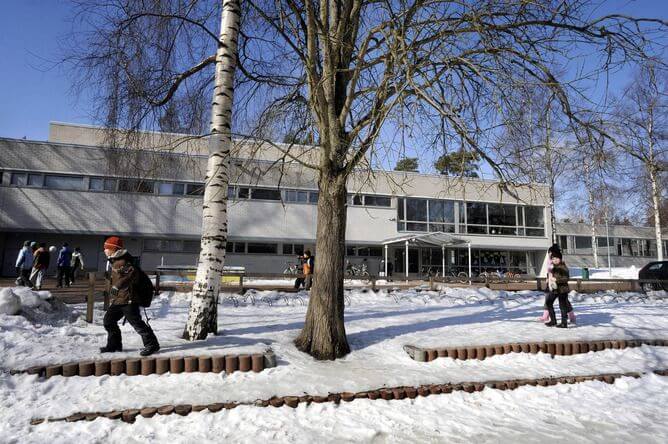![]()
作者/Pasi Sahlberg
編譯/繆謙伶
[tabs]
[tab title=”中文”]
主題式跨界學習 芬蘭教育再進化

近年來,芬蘭教育的成功吸引許多國家爭相仿效。日前因為英國獨立報的報導,芬蘭的教育制度又再次受到全球矚目。
芬蘭未來將不再單獨教授歷史、物理等科目,取而代之的是整合的「主題式」課程。像是歐盟、社區與氣候變遷、芬蘭百年獨立史等課程主題,就囊括了跨學科的語言、地理、科學和經濟,讓學生能以有系統的方式學習與該主題相關的知識。
芬蘭之所以能這麼做,是因為芬蘭的教育制度有兩個最重要的特點。第一,芬蘭的教育治理(education governance)非中央集權,中央政府僅提供課綱及補足地方政府對學校的補助款,芬蘭320個自治市(municipalities)皆能自行規畫最適合當地的教育方式。
第二、芬蘭國家課綱的標準寬鬆,留給各地方學校和老師很大的空間,能依學生的學習狀況調整教學方式。所以各校的制度除了因地制宜,也會因為不同狀況而有所差異。
主題式教學
芬蘭的國家課綱(National Curriculum Framework,NCF)規定了學校教育的總體目標和教授科目,並訂出特殊教育、諮商輔導和學生評量的綱要。新課綱將在2016年八月生效,其中主要的更新內容就是「主題式」(phenomenon-based)教學,以跨學科主題取代個別學科的學習。
其實這樣的學科整合教學方式在芬蘭並非首見。早在1980年代,芬蘭便開始實驗淘汰科目別的上課方式,許多學校也因此保留了主題式教學的部分精神。過去習慣埋首於自己專業學科的老師,能因為新教改而有更多機會和其他學科的老師合作。
學校自訂課程內容
新課綱於2016年生效後,基礎教育(7至16歲)的學校必須提供至少一門跨學科的主題式課程,課程長度由學校自行規畫。芬蘭首都赫爾辛基已經決定市內所有學校的學生都要上兩年包含所有學科的主題式課程。
長年在「國際學生能力評量」(PISA)中表現不俗的芬蘭,最新2012年的表現卻明顯下滑,政府怎麼還敢堅持要在這時推動主題式教學呢?因為芬蘭的教育人士認為,學校應該教學生未來所需的知識,而非專注於提升考試分數。現在芬蘭的學子更需要完整的知識和能力,來面對各種全球議題。主題式教學既能促進各科老師的合作,也能讓學生的學習變得更有意義。
學生參與課程規劃

許多關於芬蘭新教改的報導都忽略了一個最驚人的面向,那就是學生必須要參與主題式教學時程的規劃;學校在評量學習成果時,也一定要開放讓學生表達意見。芬蘭有些老師認為新教改無法成功改善教學和學習效果,但也有老師認為新教改打破傳統學科的分野和各科老師各自為政的習慣,有機會徹底改變教育制度。2016年新課綱生效後,有些學校會藉此機會重新設計課程,有些學校僅會適度調整。無論如何,芬蘭的基礎教育目前還是會教授各門學科,只是方式不同罷了。
【作者介紹:Pasi Sahlberg】
芬蘭教育家、作家和學者,著有《芬蘭教育這樣改》一書。曾任芬蘭教育與文化部所屬之國際事物交流與合作中心(Center for international mobility and cooperation,CIMO)主任,現為美國哈佛大學教育研究所客座教授。個人網站:http://pasisahlberg.com/
[/tab]
[tab title=”English”]
Finland’s school reforms won’t scrap subjects altogether

Finland’s plans to replace the teaching of classic school subjects such as history or English with broader, cross-cutting “topics” as part of a major education reform have been getting global attention, thanks to an article in The Independent, one of the UK’s trusted newspapers. Stay calm: despite the reforms, Finnish schools will continue to teach mathematics, history, arts, music and other subjects in the future.
But with the new basic school reform all children will also learn via periods looking at broader topics, such as the European Union, community and climate change, or 100 years of Finland’s independence, which would bring in multi-disciplinary modules on languages, geography, sciences and economics.
It is important to underline two fundamental peculiarities of the Finnish education system in order to see the real picture. First, education governance is highly decentralised, giving Finland’s 320 municipalities significant amount of freedom to arrange schooling according to the local circumstances. Central government issues legislation, tops up local funding of schools, and provides a guiding framework for what schools should teach and how.
Second, Finland’s National Curriculum Framework is a loose common standard that steers curriculum planning at the level of the municipalities and their schools. It leaves educators freedom to find the best ways to offer good teaching and learning to all children. Therefore, practices vary from school to school and are often customised to local needs and situations.
Phenomenon-based learning
The next big reform taking place in Finland is the introduction of a new National Curriculum Framework (NCF), due to come into effect in August 2016.
It is a binding document that sets the overall goals of schooling, describes the principles of teaching and learning, and provides the guidelines for special education, well-being, support services and student assessment in schools. The concept of “phenomenon-based” teaching – a move away from “subjects” and towards inter-disciplinary topics – will have a central place in the new NCF.
Integration of subjects and a holistic approach to teaching and learning are not new in Finland. Since the 1980s, Finnish schools have experimented with this approach and it has been part of the culture of teaching in many Finnish schools since then. This new reform will bring more changes to Finnish middle-school subject teachers who have traditionally worked more on their own subjects than together with their peers in school.
Schools decide the programme
What will change in 2016 is that all basic schools for seven to 16-year-olds must have at least one extended period of multi-disciplinary, phenomenon-based teaching and learning in their curricula. The length of this period is to be decided by schools themselves. Helsinki, the nation’s capital and largest local school system, has decided to require two such yearly periods that must include all subjects and all students in every school in town.
One school in Helsinki has already arranged teaching in a cross-disciplinary way; other schools will have two or more periods of a few weeks each dedicated to integrated teaching and learning.
In most basic schools in other parts of Finland students will probably have one “project” when they study some of their traditional subjects in a holistic manner. One education chief of a middle-size city in Finland predicted via Twitter that: “the end result of this reform will be 320 local variations of the NCF 2016 and 90% of them look a lot like current situation.”
You may wonder why Finland’s education authorities now insist that all schools must spend time on integration and phenomenon-based teaching when Finnish students’ test scores have been declining in the most recent international tests. The answer is that educators in Finland think, quite correctly, that schools should teach what young people need in their lives rather than try to bring national test scores back to where they were.
What Finnish youth need more than before are more integrated knowledge and skills about real world issues, many argue. An integrated approach, based on lessons from some schools with longer experience of that, enhances teacher collaboration in schools and makes learning more meaningful to students.
Students involved in lesson design

What most stories about Finland’s current education reform have failed to cover is the most surprising aspect of the reforms. NCF 2016 states that students must be involved in the planning of phenomenon-based study periods and that they must have voice in assessing what they have learned from it.
Some teachers in Finland see this current reform as a threat and the wrong way to improve teaching and learning in schools. Other teachers think that breaking down the dominance of traditional subjects and isolation of teaching is an opportunity to more fundamental change in schools.
While some schools will seize the opportunity to redesign teaching and learning with non-traditional forms using the NCF 2016 as a guide, others will choose more moderate ways. In any case, teaching subjects will continue in one way or the other in most Finland’s basic schools for now.
【Author:Pasi Sahlberg】Pasi Sahlberg is Finnish educator, author and scholar. His expertise includes school improvement, international education issues, classroom teaching and learning, and school leadership. He is a former Director General of CIMO (Centre for International Mobility and Cooperation) at the Finland’s Ministry of Education and Culture in Helsinki and currently a visiting Professor of Practice at Harvard University’s Graduate School of Education in Cambridge, MA, USA. More on his website: pasisahlberg.com
[/tab]
[/tabs]
原文經合作媒體:《The Conversation》授權編譯,未經許可不得轉載

在〈【國外編輯部專欄】主題式跨界學習 芬蘭教育再進化〉中有 1 則留言